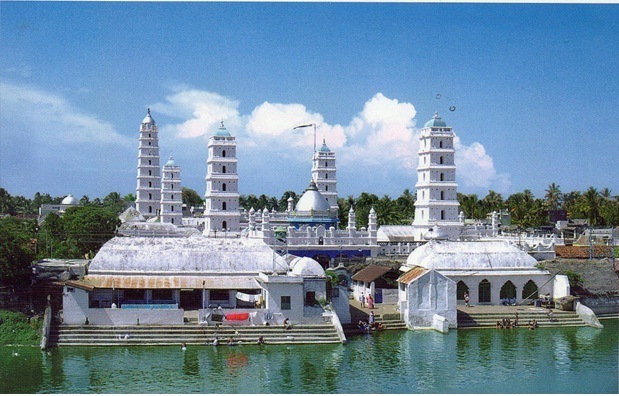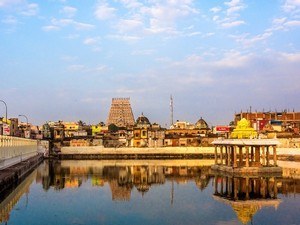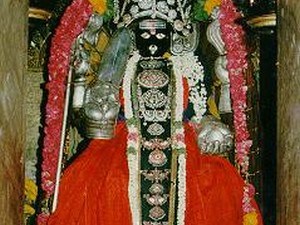Nagore, Thanjavur - Timings, Festivals, History, Darshan, Pooja Timings
Photo Credit: Flickr
 #8 of 31 Places to Visit in Thanjavur
#8 of 31 Places to Visit in Thanjavur
 Distance (From Thanjavur): 85 Kms
Distance (From Thanjavur): 85 Kms
 Trip Duration (Including Travel): 1-2 Hours
Trip Duration (Including Travel): 1-2 Hours
 Place Location: Between Nagapattinam & Karaikal
Place Location: Between Nagapattinam & Karaikal
 Transportation Options: Bus / Cab
Transportation Options: Bus / Cab
 Travel Tips: This place is usually visited from Nagapattinam (9 Kms)
Travel Tips: This place is usually visited from Nagapattinam (9 Kms)
About Nagore
At a distance of 9 Km from Nagapattinam, 14 Km from Karaikal, 85 Km from Thanjavur, Nagore is a town in the Nagapattinam District of Tamil Nadu, India. This is a place of unparalleled grandeur where history, culture, and spirituality merge to create a truly divine experience. It is the border line town between Tamilnadu and Pondicherry. The prime attraction of the town is the Nagore Dargah Shareef dedicated to the 16th century saint Meeran Sahib. This 16th century Islamic shrine attracts millions of pilgrims irrespective of caste, creed or religion as part of Thanjavur luxury tour packages.
History of Nagore
Achutappa Nayak, the ruler of Thanjavur in the 16th century, generously allocated 200 acres (81 hectares) of land to the followers of Shahul after the saint alleviated the king's suffering. A dargah was subsequently established on a portion of this donated land. It is believed that Shahul Hamid foresaw his own demise and provided guidance to his adopted son, Yusuf, regarding his burial site and the rituals to be observed posthumously. Following these instructions, Yusuf chose to reside at the location for the remainder of his life, and a mausoleum was erected over the grave. Devotees of Shahul, who maintained their faith in his spiritual abilities even after his passing, revered the burial site. Initially modest in size, the shrine gradually gained significance. Pratap Singh (1739 - 1763 AD), the Hindu Maratha monarch of Thanjavur, prayed for a son and, upon the fulfillment of his wish, constructed the tallest of the five minarets, known as Periya Manara, which stands at a height of 131 feet (40 meters).
In later years, the Marathas became benefactors of the dargah, with King Thuljaji, the son of Pratap Singh, contributing 4,000 acres (1,600 hectares) of agricultural land to the site. During the late 18th century, amidst conflicts involving European powers, the Nawab of Arcot, the Maratha rulers, and Tipu Sultan of Mysore over the Thanjavur region, the dargah was regarded as strategically significant by all parties involve
Mythology of Nagore
According to local folklore and historical documentation, Shahul Hamid is reputed to have healed Achutappa Nayak, a Hindu ruler of Thanjavur who reigned from 1529 to 1542 AD, from a physical ailment attributed to sorcery. During his intervention, Shahul Hamid discovered a pigeon with needles embedded in it within the palace, which was believed to be the source of the ruler's suffering. By extracting the pins from the pigeon, he facilitated an improvement in the king's health. In commemoration of this event, the practice of setting pigeons free in the premises of the dargah is continued by worshipers in modern times.
Things to do in Nagore
The prime attraction is of Nagore is the renowned Nagore Dargah, officially known as Hazrat Syed Shahul Hameed Dargah. This dargah was constructed over the tomb of the Sufi saint Hazrath Nagore Shahul Hamid (1490-1579 CE) by devoted followers, with significant contributions from the Hindu community. Shahul Hameed is reputed to have performed numerous miracles in Nagore, including the healing of King Achutappa Nayak, a 16th-century Hindu monarch of Thanjavur. He is affectionately referred to as Nagore Andavar, meaning the 'god of Nagore.'
Spanning approximately five acres, the Nagore Dargah showcases a harmonious blend of Indian and Islamic architectural styles, featuring impressive minarets, a dome, and elaborate carvings that embellish the shrine. The dargah comprises five minarets, with the tallest one constructed by the Hindu Maratha ruler of Thanjavur, Pratap Singh (1739-1763 CE). The main sanctum houses the tomb of Shahul Hamid, which is believed to possess curative properties. The dargah complex also includes a mosque, prayer halls, and facilities for devotees to engage in prayers and rituals. Within the dargah grounds lies the Shifa Gunta, a sacred pool.
The Vanjur shrine and Silladi shrine, situated outside the main complex, are linked to the Nagore Dargah. The Vanjur shrine is an underground cave located 2 kilometers north of the main complex, where it is believed that Shahul meditated for 40 days. The Silladi shrine, positioned 1 kilometer to the east of the main complex and facing the Bay of Bengal, is where Shahul is thought to have offered daily prayers. The dargah serves as a significant pilgrimage site, attracting devotees from both Islam and Hinduism, thereby symbolizing the harmonious coexistence of these two faiths.
Nagore Beach draws a considerable number of tourists throughout the year, offering various water sports activities. Additionally, bird watching is a popular pastime in this area. Another notable attraction in Nagore is the Arulmigu Thirunageswara temple, which is dedicated to Lord. Visitors can see the very beautiful carvings done inside the temple and on the walls of the temple.
Festivals of Nagore
The Kanduri Festival, also known as Urus Mubarak, is the most significant event observed at Nagore Dargah. This 14-day celebration occurs annually to honor the death anniversary of Saint Shahul Hamid, specifically on the 10th day of Jamadul Akhir. The festivities commence with the raising of a sacred flag, which is transported to the dargah via chariots. A key highlight of the festival is the participation of Fakhir Jamas (mendicant priests) and Qalandars, who are the saint's disciples and play a vital role in the proceedings. A pir (disciple) is chosen to offer prayers to the saint, and throws lemons at the end of the prayers on devotees, which is believed to provide miraculous relief to worldly sorrows. On the evening of the ninth day of the Akhir month in the Islamic calendar, a chariot carrying sandal paste is drawn through the streets of Nagore by pilgrims and devotees, accompanied by the sound of musical instruments. This festival is also regarded as a sacred interaction between Hindus and Muslims, symbolizing the unity of diverse faiths in the region. Additionally, Milad Nabi, the birthday of the Prophet, is celebrated with considerable fervor.
Dress Code & Other Restrictions of Nagore Dargah
When planning a visit to the Nagore Dargah, it is advisable to wear modest attire and refrain from donning tight or revealing garments. Visitors are expected to cover their shoulders, arms, and legs. Women are encouraged to use a scarf or headscarf to cover their heads.
The Nagore Dargah serves as a significant place of worship for followers of various faiths. According to the dargah's administration, approximately 50-75 percent of the pilgrims who visit daily are Hindus. While women are permitted to worship and gather in the courtyard surrounding the shrine, access to the innermost area, which houses the tomb of the saint, is restricted for them.
Nagore Dargah Timings
Monday: Outer door: 4 AM - 10 PM & Internal Door: 4:30 AM - 7 AM & 6:30 PM to 9:30 PM
Tuesday: Outer door: 4 AM - 10 PM & Internal Door: 4:30 AM - 7 AM & 6:30 PM to 9:30 PM
Wednesday: Outer door: 4 AM - 10 PM & Internal Door: 4:30 AM - 7 AM & 6:30 PM to 9:30 PM
Thursday: Outer door: 4 AM - 10 PM & Internal Door: 4:30 AM - 7 AM & 6:30 PM to 9:30 PM
Friday: Outer door: 4 AM - 10 PM & Internal Door: 4:30 AM - 7 AM, 12 PM - 2:30 PM & 6:30 PM to 9:30 PM
Saturday: Outer door: 4 AM - 10 PM & Internal Door: 4:30 AM - 7 AM & 6:30 PM to 9:30 PM
Nagore Dargah Entry Fee
Entry is Rs. 5 per Person & Rs. 50 for Parking
Best Time to Visit Nagore
Winter from December to February is the best time to visit Nagore when the weather is pleasant, and suitable for outdoor activities. Additionally, the annual Urus festival at Nagore Dargah, typically occurring in the Islamic month of Rajab, is another prime time to experience the area, offering a vibrant display of the region's cultural heritage. Conversely, the months of April to May are marked by elevated temperatures, and the onset of the monsoon season brings significant rainfall, further increasing humidity levels. Consequently, it is recommended to refrain from visiting Velankanni during the summer and monsoon periods.
How to Reach Nagore
The closest airport to Nagore is Trichy Airport, situated approximately 146 kilometers away. Nagore Railway Station offers excellent connectivity to Trichy, Karaikal, Pondicherry, and Chennai. The bus transportation system in Nagore is highly efficient, linking the city to all major cities in Tamil Nadu, as well as towns in Karnataka, Kerala, and Andhra Pradesh. Travelers can take advantage of daily bus services from Nagore to destinations such as Kanyakumari, Trichy, Chennai, Thanjavur, Trivandrum, Madurai, and Pondicherry.















